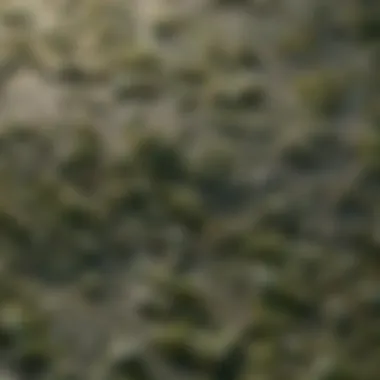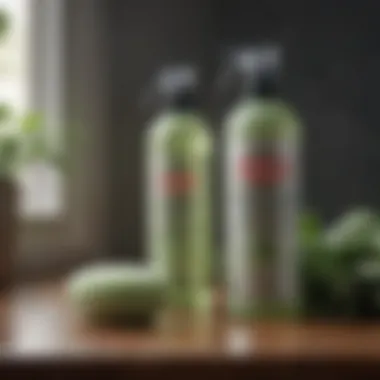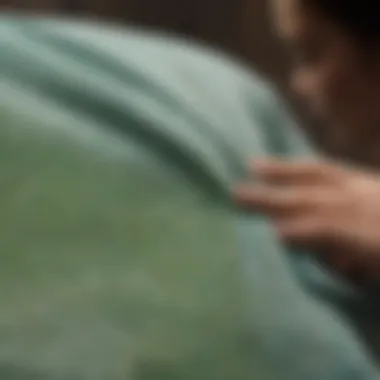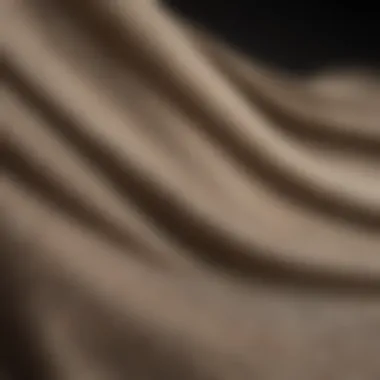Choosing the Right Mildew Remover for Fabric


Intro
Mildew can be a persistent problem, especially on fabrics. This unwanted growth can occur in various environments, often due to moisture and warmth, making it essential to understand how to deal with it effectively. Recognizing the right mildew remover for fabrics is crucial for maintaining cleanliness and integrity in your textiles. In this guide, we will explore factors that contribute to mildew growth, different types of mildew removers, their effectiveness, and preventive measures to avoid future infestations.
Mildew is a form of fungus that thrives in damp environments. It appears as a slimy, often discolored patch on clothing, curtains, or upholstery. This problem is not just aesthetic; it can lead to potential health concerns if left unchecked. Identifying the right mildew remover involves an understanding of the type of fabric, the nature of the mildew, and the ingredients in the remover.
In the following sections, you will find detailed discussions about the causes of mildew growth on textiles, the different product categories of mildew removers, and the safety precautions to consider when using these products. You will also discover application methods to ensure maximum effectiveness, along with tips for future prevention. Ultimately, this guide aims to equip you with the knowledge needed for informed choices regarding fabric care.
Understanding Mildew and Its Effects on Fabric
Mildew is more than just an unsightly blemish on your favorite fabrics. Understanding it is paramount for maintaining the integrity and cleanliness of textiles. When neglected, mildew can lead not only to irreversible stains but also to the degradation of the fabric's fibers. This section will break down the essential elements of mildew—its definitions, how it forms, and factors that encourage its growth. Each aspect is critical in equipping consumers with knowledge to tackle mildew effectively.
Definitions and Characteristics of Mildew
Mildew is a specific type of fungus that thrives in damp, warm, and poorly ventilated conditions. It often appears as a powdery or downy coating, commonly characterized by a white, gray, or greenish hue. The presence of mildew is more than cosmetic; it indicates an active fungal environment that can compromise the structure of the fabric. Understanding these characteristics is crucial for anyone looking to maintain their textiles, especially in humid or wet environments.
How Mildew Forms on Fabric
Mildew formation on fabric requires a set of conditions. It begins with moisture. When fabric retains moisture, whether from washing, outdoor weather, or spills, it creates a conducive environment for mildew spores, which are airborne and nearly omnipresent, to settle. Over time, if the fabric remains damp, these spores germinate. Understanding this process helps in anticipating potential mildew issues before they escalate.
Factors Contributing to Mildew Growth
Several factors contribute to mildew growth on fabric:
- Humidity Levels: High indoor or outdoor humidity directly increases the likelihood of mildew.
- Poor Ventilation: Fabrics that are stored in poorly ventilated spaces trap moisture.
- Temperature: Warm temperatures accelerate the growth rate of mildew.
- Material Composition: Certain fabrics, such as cotton, are more prone to mildew than synthetic materials, which resist moisture.
Recognizing these factors empowers users to take preventative measures, ensuring their fabrics remain in optimal condition.
"Prevention is the key to avoiding the entrenched issues caused by mildew on fabrics."
Overall, a strong grasp of mildew and its implications is invaluable. Since mildew can lead to discolored and weakened fabrics, knowledge on this subject serves as the foundation for effective mildew management.
Categories of Mildew Removers for Fabric
Understanding the different categories of mildew removers for fabric is essential for effective mildew management. Different products cater to various fabrics, conditions, and personal preferences. Knowing how to choose the right category can prevent damage to textiles while ensuring effective mildew removal. The right choice not only addresses current mildew issues but also contributes to a healthier living environment.
Chemical Mildew Removers
Chemical mildew removers are widely utilized for their efficacy in combating mildew effectively. Composed of robust active ingredients, these products often yield results quickly. Brands like Clorox and OxiClean offer mildew removers that are designed specifically for fabric, targeting tough stains and persistent odors.
The effectiveness of chemical removers comes with precautions. Many contain potent formulations that can harm delicate fabrics. Therefore, it's important to read the labels and recommendations carefully. Always perform a patch test prior to using a new chemical product. This can help prevent any unwanted reactions.
Natural and Eco-Friendly Options
With increasing awareness about environmental sustainability, natural and eco-friendly mildew removers have gained popularity. Products featuring ingredients such as vinegar, baking soda, and essential oils can effectively remove mildew without harming the environment. These options are less aggressive than chemicals but can be equally effective when used correctly.
For instance, a mixture of white vinegar and water can effectively clean mildew from fabric surfaces. Alternatively, baking soda can be applied as a scrub to lift stubborn stains. These natural solutions provide a safer approach, especially for families with kids or pets, while still addressing the mildew issue.


Homemade Remedies for Mildew Removal
Homemade remedies present an interesting alternative for those looking to save money or avoid commercial products. Common household items can be repurposed as effective mildew removers. Simple combinations such as using lemon juice mixed with salt can create a paste that is applied to stained fabrics.
The benefits of homemade solutions include cost-effectiveness and customization to personal preferences. However, users should keep in mind that results can vary based on the severity of the mildew and the type of fabric. As with all remedies, a patch test is recommended to ensure there are no adverse effects on the material.
Choosing the right mildew remover depends on personal needs, the fabric in question, and environmental considerations. Chemical, natural, and homemade solutions each offer unique benefits.
Evaluating the Effectiveness of Mildew Removers
Understanding the effectiveness of mildew removers is crucial for anyone seeking to keep fabric clean and free from unwanted growth. Effective mildew removal directly impacts the longevity and cleanliness of textiles. Factors such as product formulation, application method, and user satisfaction all play significant roles in evaluating how well a mildew remover works. A good mildew remover should effectively eliminate mildew without damaging the fabric.
Testing for Mildew Growth Reduction
Testing varies greatly depending on the fabric and the type of mildew. Controlled experiments that measure mildew count before and after treatment can provide insight into the product's effectiveness. It is essential to choose a method that aligns with the fabric's care instructions. Swabbing the fabric before and after with sterile tools can give objective results. Consumers should look for products that have shown significant results in reducing mildew growth in these tests, as this translates to real-world efficiency.
User Reviews and Testimonials
Personal experiences shared through user reviews are valuable resources. Platforms like Reddit and specialized cleaning forums can reveal how well a product performs under typical conditions. Reviews often discuss not only the effectiveness of the mildew remover but also ease of use, convenience, and fabric safety. Recommendations from fellow users provide practical insights that enhance decision-making.
Comparison of Popular Products
When comparing popular mildew removers, several factors must be considered. Ingredients, application methods, and effectiveness vary. Some products may excel in removing mildew but could potentially harm delicate fabrics. For instance, products like OxiClean MaxForce may perform well on robust materials, while specialized fabric cleaners like Rug Doctor may be needed for more delicate textiles. Analyze product labels and customer feedback ensuring the removal method aligns with the specific fabric type to achieve optimal results.
Evaluating effectiveness is not just about removing stains; it involves preserving the fabric's integrity while achieving a clean environment. By testing products, checking reviews, and making thoughtful comparisons, consumers can identify the best mildew remover for their needs.
Safety Considerations When Using Mildew Removers
Understanding safety considerations when using mildew removers is crucial for anyone handling these products. Mildew removers can contain chemicals that may pose health risks. It is essential to grasp these safety guidelines to ensure effective use without compromising your well-being or that of others. The following subsections will detail the hazards, protective measures, and environmental concerns associated with mildew removers.
Understanding Chemical Hazards
Mildew removers can include various chemical agents like sodium hypochlorite, hydrogen peroxide, or quaternary ammonium compounds. Each of these has specific properties, and their effectiveness varies based on the type of mildew involved. However, chemical exposure can lead to respiratory problems, skin irritation, and eye damage. It is important to read the product label thoroughly to be aware of any potential hazards.
Inhalation of fumes can cause headaches or dizziness, especially in poorly ventilated areas. Knowing these hazards will help mitigate risks while using these products. If you have sensitive skin, it may be wise to test a small area first before full application.
Protective Equipment and Precautions
When working with mildew removers, wearing protective equipment is not just advisable; it is essential. Here are some recommended items:
- Gloves: Use rubber or latex gloves to shield your skin from direct contact with chemicals.
- Goggles: Protect your eyes from splashes, as some removers can cause serious irritation.
- Mask or Respirator: This helps filter out harmful fumes, especially in confined spaces.
Aside from personal gear, ensure the area is well-ventilated before applying any mildew remover. Open windows and doors if possible. Consider using fans to improve airflow. Avoid mixing different products, as this can create toxic gases. Following these precautions can enhance your safety and efficiency during the cleaning process.
Environmental Impact of Cleaning Agents
The environmental impact of mildew removers should also be taken into account. Many commercial products contain chemicals that can contaminate water sources if not disposed of correctly. Natural and eco-friendly options often provide safer alternatives. These products are typically biodegradable and less harmful to aquatic life.
Additionally, consider local regulations regarding chemical disposal. Never pour mildew removers down drains unless specified by the manufacturer. Opt for concentrated formulas that minimize plastic waste or create DIY solutions using vinegar or baking soda. These actions contribute to sustainability, helping to preserve our environment.


"Safety is not just a set of rules, it is a culture built over time. Protect yourself and our environment when using mildew removers."
By understanding chemical hazards, utilizing protective equipment, and acknowledging environmental concerns, individuals can ensure safe and effective mildew removal. Making informed choices fosters cleaner textiles without risking health and environmental quality.
Methodology for Using Mildew Removers on Fabric
The methodology for using mildew removers on fabric is crucial for achieving optimal results in cleaning and maintaining textiles. A structured approach ensures that the chosen product is applied effectively, minimizing the risk of damage to the fabric while maximizing mildew removal. Understanding specific elements within this methodology can lead to better outcomes. The following sections will delve deeper into preparation, application techniques, and post-cleaning care. Each of these components contributes to the effectiveness of the entire remediation process.
Preparation Steps Before Application
Before applying any mildew remover, proper preparation is essential. This stage involves gathering materials and inspecting the fabric.
- Selecting the Right Product: Choose a mildew remover that is suitable for the type of fabric being treated. Check the label for recommendations and compatibility.
- Testing on a Small Area: Always perform a patch test in an inconspicuous area. This helps to identify any adverse reactions or discoloration that may occur.
- Cleaning the Surface Area: Remove any loose dirt or debris from the fabric. This can involve lightly brushing off the surface or shaking out the cloth to prevent further contamination.
- Reading Instructions: Understand the directions provided by the manufacturer. Each product may have distinct requirements and guidelines based on its formulation.
- Setting Up the Work Area: Choose a well-ventilated location to apply the remover. Good airflow is necessary to reduce the concentration of fumes and promote faster drying of the fabric.
Application Techniques for Effective Results
Applying mildew remover requires a methodical approach to ensure that every affected area is treated evenly.
- Spraying Technique: If the remover is in spray form, apply it evenly over the fabric from a distance of about 6-12 inches. This prevents excess application leading to saturation.
- Soaking Method: For fabrics that can handle water, soaking might be an option. Ensure to fully submerge the fabric and gently agitate if applicable, according to product guidelines.
- Using a Cloth or Sponge: For targeted application, use a clean cloth or sponge to dab the remover onto the mildew-affected areas. This method provides more control and avoids oversaturation.
- Allow Proper Dwell Time: After application, allow the remover to sit for the recommended dwell time. This duration varies depending on the product and the extent of mildew growth. This allows for deeper penetration into the fabric fibers.
Drying and Post-Cleaning Care
Post-cleaning care is as important as the application technique to ensure the mildew does not return and the fabric maintains its integrity.
- Rinse Thoroughly: Depending on the instructions, rinse the fabric thoroughly with clean water to eliminate any residue of the remover. Residual chemicals can attract dirt or contribute to damage.
- Dry Properly: Drying can be done air drying or using a dryer, based on the fabric type. Always refer to the care instructions to avoid shrinking or warping.
- Storage Considerations: Once dry, store the fabric in a cool, dry place to minimize humidity. This helps to deter future mildew growth.
In summary, a well-defined methodology for using mildew removers on fabric encompasses careful preparation, effective application techniques, and thorough post-cleaning care. By adhering to these guidelines, users can significantly enhance their chances of removing mildew without damaging their cherished textiles.
"A structured approach ensures success in mildew removal and long-lasting fabric care."
For further insights on mildew and cleaning practices, you can explore additional resources like Wikipedia and Britannica.
Short- and Long-Term Prevention Strategies
Short- and long-term prevention strategies are vital for keeping fabrics free from mildew. Understanding and implementing these practices can dramatically reduce the risk of mildew growth, which can damage textiles and affect their longevity. By focusing on specific prevention methods, individuals can not only enhance the durability of their fabrics but also maintain a healthy living environment.
Proper Storage Practices
Correct storage of fabrics is essential in preventing mildew. Fabrics should be stored in a dry, well-ventilated area. Here are some key points to consider:
- Use breathable storage containers: Avoid plastic bags that trap moisture. Instead, opt for cotton bags or boxes with ventilation holes.
- Keep fabrics clean: Always ensure that fabrics are clean and dry before storing them. Stains or moisture can encourage mildew growth over time.
- Avoid overcrowding: Too many items in one space can hinder air flow. Make sure to leave space around items to allow for proper ventilation.
Storing fabrics correctly may seem simple, but it can have a major impact on their longevity and care.
Maintaining Optimal Humidity and Temperature
Humidity and temperature levels play a crucial role in mildew prevention. Understanding how these factors contribute to mildew growth can help individuals manage their fabric care better. Consider the following:
- Monitor humidity levels: Ideally, indoor humidity should be kept between 30% to 50%. Use a dehumidifier in damp areas to maintain this range.
- Regulate temperature: Keep indoor spaces cool. High temperatures, combined with humidity, create an ideal environment for mildew.
- Ventilate regularly: Open windows and use fans to enhance air circulation in homes, particularly in areas prone to moisture buildup, like basements and bathrooms.


Routine Cleaning Habits
Implementing routine cleaning habits is essential for long-term prevention of mildew. Regular maintenance supports not only the fabric's appearance but also its integrity. Here are some cleaning practices to adopt:
- Wash fabrics frequently: Establish a regular schedule for washing fabrics, especially those that are used often or can trap moisture.
- Use mildew-resistant products: When cleaning, consider using fabric cleaners that offer mildew protection. This adds an additional layer of security against growth.
- Inspect for signs of mildew: Regularly check stored fabrics for any early signs of mildew growth. Detecting problems sooner rather than later can prevent more extensive damage.
By focusing on these prevention strategies, individuals can make informed decisions that protect their fabrics from mildew both in the short and long term. Establishing good habits in storage, environment management, and cleaning will create a sustainable approach to maintaining fabric integrity.
Case Studies: Real-Life Applications
In the pervasive landscape of mildew removal, examining real-life applications provides invaluable insights into the practical use and effectiveness of various mildew removers. This section serves to illustrate how different households and professionals tackle mildew challenges. By drawing from both everyday scenarios and commercial experiences, we highlight the effectiveness of these products in real situations, providing readers with concrete examples that can inform their own choices.
Home Use Scenarios
Households frequently encounter mildew issues, particularly in areas prone to moisture, such as bathrooms and basements. A common scenario involves a family discovering unsightly mildew on their fabric shower curtain. Using a commercial mildew remover such as Clorox Fabric Sanitizer, they follow the instructions to treat the curtain. The application process typically involves spraying the remover directly onto the affected areas, letting it sit for a specified amount of time, and then rinsing thoroughly.
Users often report significant improvement, observing that the mildew stains lighten or disappear completely. It is also essential to note that manual cleaning with a brush can enhance effectiveness. However, routines such as proper drying and storage after cleaning are vital for long-term results. This reinforces the idea that proactive maintenance is just as crucial as remedial actions.
Professional Cleaning Contexts
In professional cleaning settings, mildew removal becomes a systematic task, especially for services like carpet cleaning or textile maintenance in hotels. For instance, a hotel may experience mildew on upholstery due to humidity. Professional cleaners often opt for industrial-grade products like Bissell Mildew Remover. These products offer a more potent action and quicker results.
The cleaning team usually prepares the fabric by vacuuming and applying the remover in well-ventilated areas. The efficacy of these products is often evaluated post-application with visual inspections and feedback from guests. The removal of mildew is critical for maintaining aesthetic appeal and guest satisfaction. The contrast between home and professional use emphasizes how product selection can vary based on the scale of mildew growth and the desired speed of results.
Unconventional Uses of Mildew Removers
Mildew removers are not limited to strictly cleaning fabrics. Some users have found innovative alternative applications that extend the utility of these products. For example, individuals may choose to use a diluted solution of Nature's Miracle Mold and Mildew Remover to clean outdoor fabric structures like awnings or patio cushions. This approach, while not conventional, showcases versatility.
Another unconventional use could be the treatment of mildew found in vehicles, such as cloth seats or carpets that have endured damp conditions. Applying fabric-safe mildew cleaners allows users to address mildew growth without replacing the fabric. However, caution is advised, as improper use could lead to fabric damage. These unconventional applications illustrate the importance of understanding the product specifications and suggested uses before proceeding.
"The skin of the earth has many blemishes, yet neglect not their resolution, for mildew can seem a trivial matter, but its impact multiplies if overlooked."
Exploring these real-world examples not only provides practical context but also encourages readers to consider innovative solutions for their own mildew challenges. The insights here serve to bridge theoretical knowledge with tangible practice, aiding in a comprehensive understanding of mildew remediation.
Ending: Choosing the Best Mildew Remover for Your Needs
Selecting the right mildew remover for fabric is crucial for maintaining both the appearance and longevity of your textiles. A suitable mildew remover not only eliminates existing stains but also helps prevent future growth. When faced with various options in the market, understanding your priorities and preferences can lead to a more satisfying result. The overarching goal is to find a product that aligns with your values while effectively addressing your mildew concerns.
Assessing Personal Priorities
Before making any purchase, it's essential to evaluate your specific needs and circumstances. Consider the types of fabrics you regularly encounter that may be affected by mildew. Certain fabrics, like cotton, might react differently to specific removers compared to more delicate materials like silk or wool. Your priority may also extend to the ecological impact of the products you choose. If sustainability is important to you, opting for a natural or eco-friendly option might be preferred. Additionally, think about your budget and how much you are willing to spend on mildew removal compared to long-term fabric care.
A personal assessment can include the following questions:
- What fabrics do I need to treat?
- Am I concerned about the environment and chemical exposure?
- What is my budget for preventive measures and treatments?
- Are there specific allergies or sensitivities to consider?
By clarifying these priorities, you empower yourself to make a well-informed choice when selecting a mildew remover.
Final Recommendations Based on Evaluation
After considering personal priorities, it becomes easier to narrow down options for mildew removers. The effectiveness of various products can vary greatly depending on their formulations. If your fabric is heavily affected, a chemical mildew remover might offer the most immediate result. However, if you prefer a gentle approach or are treating delicate materials, a natural or homemade solution could be advisable.
Here are some recommendations based on evaluations:
- For Severe Mildew Stains: Look for commercial products like RMR-86 or Klean Strip M-1 that are proven to handle tough mildew issues efficiently.
- For Eco-Friendly Choices: Products such as Nature's All-Purpose Cleaner or a homemade solution combining vinegar and baking soda may work well while aligning with environmentally conscious choices.
- For General Maintenance: Regular cleaning routines with products like OxiClean or simple soapy water can help keep fabrics fresh and prevent future growth.



